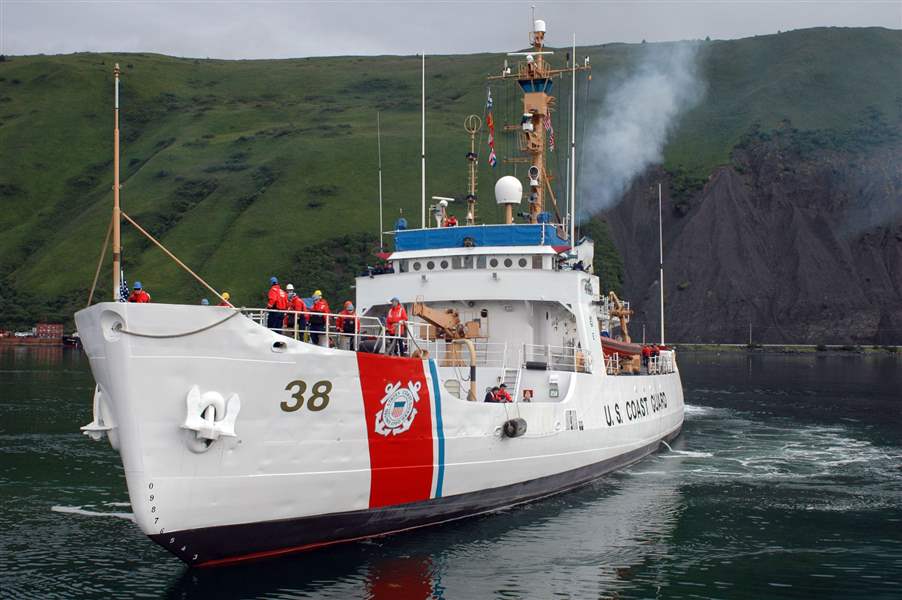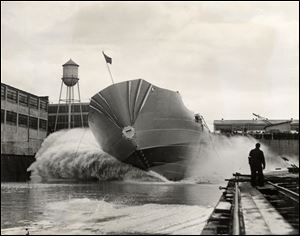
Storis Museum’s dream in peril
Cutter could come to Toledo — or be scrap
7/15/2013
The Storis was built by the Toledo Shipbuilding Co. and commissioned in 1942. Efforts to buy it from the federal government met bureaucratic obstacles.
U.S. COAST GUARD

The Storis was built by the Toledo Shipbuilding Co. and commissioned in 1942. Efforts to buy it from the federal government met bureaucratic obstacles.
The fate of the U.S. Coast Guard cutter Storis, which was built in Toledo, finally appeared settled in early June after six years of uncertainty.
The Storis, one of America's most accomplished and longest-serving vessels, was on the verge of returning home to Toledo to become the site of an educational and historical museum. Now, however, the ship seems headed to another end: The scrapyard.
But not if the Storis Museum can help it.
The Storis’ nearly 65-year run began on April 4, 1942, when it plunged into the water at the Toledo Shipbuilding Co. yards.
Its most notable achievement came in 1957 when it was one of three ships that were the first American vessels to circumnavigate North America via the Northwest Passage.
The ship served in the Atlantic Ocean in World War II, protected the Alaskan coast from Soviet threats during the Cold War, and spent much of its later years performing search and rescue operations and fisheries enforcement before it was decommissioned in 2007. Its impressive career earned it a spot on the National Register of Historic Places on Dec. 31, 2012.
But the Storis was sold by the General Services Administration to an unidentified buyer — most likely the head of a scrapping company — at auction for $70,100 on June 27, despite the nonprofit Storis Museum's efforts since 2007 to secure the ship through both congressional and administrative means.
Storis Museum President Jim Loback said he found out June 7 the ship would go to auction. Before that, he thought his organization, which is based in Juneau, would have an opportunity to acquire the ship from the GSA, which was told by the Coast Guard it could start the disposal process in May.
“It was surprising because [the GSA] told me that they were all working to see if there was some way to give us the ship and then they put it up for auction,” said Mr. Loback, 81, who served on the Storis in 1956 and 1957.
According to the GSA, the disposal process consists of screening the vessel for possible transfer to federal and state agencies as well as eligible nonprofit organizations. If no eligible recipients express interest, the vessel could be sold publicly.
Mr. Loback said when he asked why the ship was put to auction, he was told his organization did not qualify for transfer because GSA rules state that a museum must be owned and operating for one year with at least one full-time paid employee to be an eligible nonprofit group. Mr. Loback, who resides in Fountain Valley, Calif., said that creates a troublesome situation.
“That's kind of a dumb rule for a ship because you're going to use the ship as a museum, and that's going to be the house and everything else for it,” he said.
There was even more confusion after the auction, because the reserve — the undisclosed minimum amount of money set prior to an auction that's needed for a bid to be accepted — wasn't met.

The Coast Guard's cutter Storis was launched in the Toledo Shipbuilding Co. yards in 1942. The ship served in the Atlantic during World War II.
Mr. Loback said he hoped this would mean more time for the Storis Museum to raise funds to purchase the vessel in a second auction with a lower reserve. However, the June 27 bid was still accepted to save taxpayer dollars and deter future government costs, according to an emailed statement from GSA regional public affairs officer Saudia Muwwakkil.
The buyer will have 10 business days to take the vessel once a certificate of financial responsibility is submitted and approved. The Storis currently sits in Suisun Bay in northern California, where the ship has been since its decommissioning.
Now the only hope for the Storis Museum to save the ship is through the winning bidder. The GSA has not released the bidder's name per privacy laws, but Mr. Loback said he was contacted by the winner about buying the ship. Mr. Loback did not wish to identify the bidder for fear of harming negotiations.
The museum had attempted to acquire the ship from 2008-12 through congressional action, but no bill was passed to transfer the ship from the Coast Guard to the Storis Museum, secretary Joe Geldhof said.
“We wanted to get Congress involved and have Congress pass it, because you don't have to deal with the shenanigans of the bureaucrats,” said Mr. Geldhof, 62, a lawyer in Juneau.
As discussions proceeded between the Storis Museum and the GSA in early May, the museum reached out to the Last Patrol, a local nonprofit group formed in 1995 that has tried unsuccessfully to bring ships for a museum to the Toledo area. On May 16, the Storis Museum and the Last Patrol formed an official legal partnership.
In early June, the two parties agreed the ship would be docked in Toledo, not Juneau, because it was more cost-efficient and because of the Maumee River's fresh water, low tides, and more visitor-appealing location.
“The plan for the ship coming to the Great Lakes was to use it as a museum ship and as a training vessel for the U.S. Naval Sea Cadet Corps. ... We wanted to have the ship back operational to help train the young kids; they range from 10-18,” said John Nowakowski, 49, of Swanton, a former Marine and commanding officer of the Last Patrol.
All that was left was transferring the ship from the GSA to the Storis Museum, which the museum and the Last Patrol thought would happen once they obtained funds necessary to repair and maintain the ship.
“We kept being told that we had anywhere from six months to a year to get everything in line,” Mr. Nowakowski said. They actually had just a few weeks before the auction.
Mr. Geldhof said he realizes the chances of buying the ship from the winning bidder are not good.
“The Storis is worthy of one last effort and we're going to give it a shot. We'll see how that goes,” Mr. Geldhof said. “We haven't given up the ship yet, and until it's actually under the torch, cut up, we'll keep trying to save it.”
Contact Sam Gans at: sgans@theblade.com or 419-724-6516.